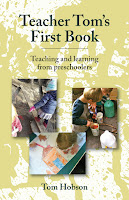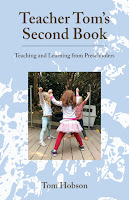We have a fantastic outdoor space, one that I consider state-of-the-art. That said, it doesn't lend itself well to all modes of play. Wheeled vehicles, for instance, are troublesome given that our terrain is largely sand, mud, or wood chip covered, without a hint of paving or flatness. Balls are likewise not well-accommodated. Not only does our terrain thwart most traditional ball games, but the sooner or later destiny of every ball is to wind up over the fence at the bottom of the hill, where it is lost forever in the impossible thicket of blackberry bramble that the city has allowed to consume the no-man's land below our school.
Every now and then, there have been children disappointed by the lack of ball play around the place. Some have even gone so far as to donate balls from their own collection only to see them suffer their inevitable fate. I enjoyed ball games as a boy, and still do as a grown man, but I long ago accepted the reality that our school cannot be all things to all people and that, at best, we are a poor host for ball-based games.
One year, however, a couple of our kids began to show a stronger than usual interest in throwing and, to a slightly lesser degree, catching. One boy in particular, a three-year-old, was fascinated by throwing objects of all sorts. Some were inappropriate for throwing, like blocks and rocks, so I was working to steer his interest toward things meant for throwing, balls among them. Coincidentally, around this time a pair of small footballs turned up around the place.
I took to playing "catch" with this boy. He had a good arm, one that he liked to test out, so had to stand a good distance apart to play our game. He struggled, however, with the catching end of things, which is quite normal for a three-year-old.
The advent of the footballs revealed an older boy who, while perhaps not as focused on throwing as his younger classmate, had two older brothers from whom he learned to both throw and catch quite well. He started joining our game of catch. In the beginning, I would take turns throwing to the boys, first the younger, who would close his eyes and allow the ball to bounce off his hands, then the older, who showed his experience by snagging even poorly thrown balls. Then one day the pattern changed. The older boy, after catching a ball I had thrown began turning to the younger boy to make a short, soft, underhanded toss to him, a ball much easier for the younger boy to catch. Then the younger boy would make the long throw down the hill to me. And this became the pattern of our game of catch, a game that allowed all of us to throw and catch at our own level.
No one told the older, more experienced boy what to do. No one even suggested it. He simply recognized what his classmate needed -- short, soft, underhanded tosses -- and accommodated him in the interest of making the game fully accessible to both of them.
As we played like this, I was taken back to my own childhood, playing kick ball in the street in front of our house, a game that included all the children who lived on our street, kids of varied ages and abilities. We never allowed our "rules" to exclude anyone. For instance, we simply adapted them to better suit Chuck, our wheel chair bound friend from across the street. He couldn't "run" as fast as the rest of us, so when it was his turn we shortened the bases and let him punch the ball with his fist. We were more gentle with the younger or less skilled kids. Rules were not hard and fast, but rather infinitely flexible, used to give structure to our game without becoming barriers to entry because, after all, if we were going to play a proper game of street kick ball we needed everyone.
Later in life, when we began to get involved with "organized" sport with its emphasis on winning and hard-and-fast rules, things changed, but when left to our own devices we tended to play both inclusively and equitably, driven by the process of the game much more than its outcome. This is a phenomenon I've witnessed time and again as a teacher in a play-based preschool. Indeed, it is so common that I've come to consider it part of human nature, something that seems to be, sadly, discouraged by our wider society. I've said it before and I'll say it again: children are no less wise than adults. The struggle is to not unlearn that wisdom as we grow older.
Every now and then, there have been children disappointed by the lack of ball play around the place. Some have even gone so far as to donate balls from their own collection only to see them suffer their inevitable fate. I enjoyed ball games as a boy, and still do as a grown man, but I long ago accepted the reality that our school cannot be all things to all people and that, at best, we are a poor host for ball-based games.
One year, however, a couple of our kids began to show a stronger than usual interest in throwing and, to a slightly lesser degree, catching. One boy in particular, a three-year-old, was fascinated by throwing objects of all sorts. Some were inappropriate for throwing, like blocks and rocks, so I was working to steer his interest toward things meant for throwing, balls among them. Coincidentally, around this time a pair of small footballs turned up around the place.
I took to playing "catch" with this boy. He had a good arm, one that he liked to test out, so had to stand a good distance apart to play our game. He struggled, however, with the catching end of things, which is quite normal for a three-year-old.
The advent of the footballs revealed an older boy who, while perhaps not as focused on throwing as his younger classmate, had two older brothers from whom he learned to both throw and catch quite well. He started joining our game of catch. In the beginning, I would take turns throwing to the boys, first the younger, who would close his eyes and allow the ball to bounce off his hands, then the older, who showed his experience by snagging even poorly thrown balls. Then one day the pattern changed. The older boy, after catching a ball I had thrown began turning to the younger boy to make a short, soft, underhanded toss to him, a ball much easier for the younger boy to catch. Then the younger boy would make the long throw down the hill to me. And this became the pattern of our game of catch, a game that allowed all of us to throw and catch at our own level.
No one told the older, more experienced boy what to do. No one even suggested it. He simply recognized what his classmate needed -- short, soft, underhanded tosses -- and accommodated him in the interest of making the game fully accessible to both of them.
As we played like this, I was taken back to my own childhood, playing kick ball in the street in front of our house, a game that included all the children who lived on our street, kids of varied ages and abilities. We never allowed our "rules" to exclude anyone. For instance, we simply adapted them to better suit Chuck, our wheel chair bound friend from across the street. He couldn't "run" as fast as the rest of us, so when it was his turn we shortened the bases and let him punch the ball with his fist. We were more gentle with the younger or less skilled kids. Rules were not hard and fast, but rather infinitely flexible, used to give structure to our game without becoming barriers to entry because, after all, if we were going to play a proper game of street kick ball we needed everyone.
Later in life, when we began to get involved with "organized" sport with its emphasis on winning and hard-and-fast rules, things changed, but when left to our own devices we tended to play both inclusively and equitably, driven by the process of the game much more than its outcome. This is a phenomenon I've witnessed time and again as a teacher in a play-based preschool. Indeed, it is so common that I've come to consider it part of human nature, something that seems to be, sadly, discouraged by our wider society. I've said it before and I'll say it again: children are no less wise than adults. The struggle is to not unlearn that wisdom as we grow older.
******
If you liked reading this post, you might also enjoy one of my books. To find out more, Click here!
"Ready for a book that makes you want to underline and highlight? One that makes you draw arrows and write 'THIS!!!!!' in the margin? Then you are in for a treat." ~Lisa Murphy, M.Ed., author and Early Childhood Specialist, Ooey Gooey, Inc.
I put a lot of time and effort into this blog. If you'd like to support me please consider a small contribution to the cause. Thank you!




